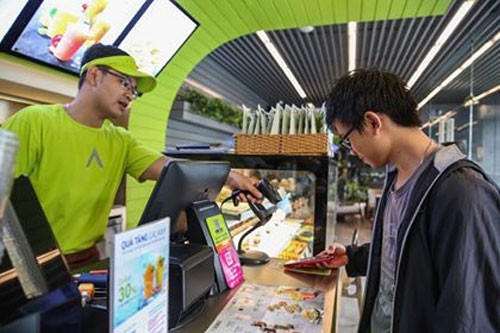The process of shifting from magnetic ATM cards to chip cards in accordance with international standard EMV is the next step in the path towards digitalization.

Chip cards lay an important foundation for the integration and application of healthcare, education, transport, insurance and public services.
According to Nguyen Minh Tam, deputy CEO of Sacombank, domestic chip cards are integrated with contactless technology which allows the payment to be made in a quicker and more convenient way.
Chip technology stored more information in cards which will serve as the foundation for banks to deploy multi-utility services, connect information such as school card, hospital card, resident card, and other types of cards for public services. Thanks to this, banks can get more clients, provide more package services, and increase non-cash payment activities.
|
Chip technology stored more information in cards which will serve as the foundation for banks to deploy multi-utility services, connect information such as school card, hospital card, resident card, and other types of cards for public services. |
Tam commented that payment service is a sector which is very ‘sensitive to technology’, so, it changes all the time. Investing money in technology renovation is costly, but it is a must because it brings more business opportunities, increases revenue and saves operation costs.
Most Vietnam’s banks have begun the process of digital transformation at the levels of process and communication channels. The transformation for database platforms, however, has been carried out only at a few pioneering banks.
TP Bank, for instance, has auto bank service LiveBank, Vietcombank has Digital Lab and it is undergoing a large-scale digital transformation project with the consultancy of PwC. VietinBank has the next-generation CoreBank, VP Bank applies digital bank Timo, and Military Bank uses chatbox which serves customers 24/7 on social networks.
Le Anh Dung, deputy director of the Payment Department of the State Bank, can see the great potential of digital banking in Vietnam with 55 percent of population using smartphones.
He also said the platform for digital banking development is solid, thanks to 18,500 ATMs, 270,000 POS, 76 commercial banks that use Internet Banking, 41 banks that use Mobile Banking and 16 banks that use QR Code at 30,000 points throughout the country.
The existence of fintechs has also created breakthroughs in financial services in Vietnam. Some years ago, banks considered fintechs as opponents, but now, they tend to cooperate with fintechs to provide new financial products to clients.
Some banks have set up fintech labs to reserve space for banks and technology firms to exchange views and ideas and to look for new solutions before developing solutions into products.
“We are joining forces with seven technology firms to develop technologically financial products. It is expected that four to five products will be launched into the market in three to six months,” a representative of VietinBank said.

Security World 2019: security for banking and state management
Cyberattacks are increasingly complicated and dangerous with an increasing number of attacks, requiring a comprehensive security solution encompassing regulations, technology, and human resources.
Trong Dat
 Commercial banks now are pouring money into digitalization in order to satisfy clients’ requirements amid financial technology breakthroughs." itemprop="description" />
Commercial banks now are pouring money into digitalization in order to satisfy clients’ requirements amid financial technology breakthroughs." itemprop="description" />